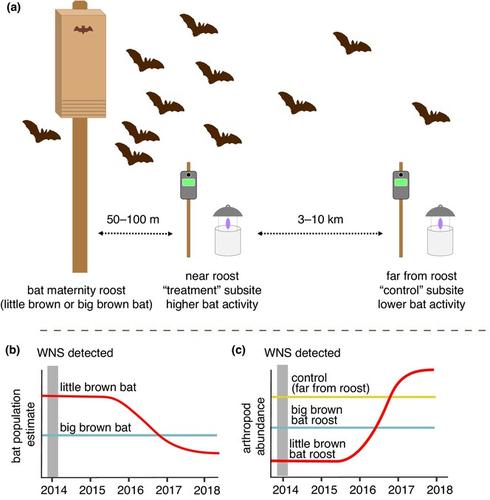当前位置:
X-MOL 学术
›
Ecol. Lett.
›
论文详情
Our official English website, www.x-mol.net, welcomes your
feedback! (Note: you will need to create a separate account there.)
Heterogenous effects of bat declines from white‐nose syndrome on arthropods
Ecology Letters ( IF 7.6 ) Pub Date : 2024-06-22 , DOI: 10.1111/ele.14437 Amy K. Wray 1 , Marcus Z. Peery 1 , Jade M. Kochanski 2, 3 , Emma Pelton 2, 4 , Daniel L. Lindner 5 , Claudio Gratton 2
Ecology Letters ( IF 7.6 ) Pub Date : 2024-06-22 , DOI: 10.1111/ele.14437 Amy K. Wray 1 , Marcus Z. Peery 1 , Jade M. Kochanski 2, 3 , Emma Pelton 2, 4 , Daniel L. Lindner 5 , Claudio Gratton 2
Affiliation

|
In North America, white‐nose syndrome (WNS) has caused precipitous declines in hibernating bat populations, raising the question of whether the rapid loss of arthropodivorous bats may affect the abundance of their prey. During the summers of 2015–2018 (1 year after the arrival of WNS in Wisconsin, USA), we performed intensive arthropod black‐light trapping, ultrasonic acoustic monitoring, and emergence counts at 10 little brown (Myotis lucifugus ) and big brown (Eptesicus fuscus ) bat maternity roosts with paired control sites. For little brown bats, which are severely affected by WNS, roost counts declined by 95% over the four‐year period, compared to a 38% decline in big brown bat roost counts. Total arthropod abundance decreased by 49%, although decreases among common little brown bat prey were less severe. Our natural predator exclusion experiment supports existing evidence that bats can have measurable trophic impacts on arthropod communities, primarily via top‐down effects on common prey.
中文翻译:

白鼻综合症引起的蝙蝠衰退对节肢动物的异质影响
在北美,白鼻综合症(WNS)导致冬眠蝙蝠数量急剧减少,这引发了一个问题:节肢动物蝙蝠的迅速消失是否会影响其猎物的丰富度。 2015年至2018年夏季(WNS抵达美国威斯康星州一年后),我们对10只小棕鼠(Myotis lucifugus)和大棕鼠(Eptesicus)进行了密集的节肢动物黑光诱捕、超声波监测和羽化计数。 fuscus)蝙蝠产妇栖息地与配对对照位点。对于受到 WNS 严重影响的小棕蝠来说,四年期间栖息地数量减少了 95%,而大棕蝠栖息地数量减少了 38%。节肢动物总丰度下降了 49%,但普通小棕蝠猎物的丰度下降程度不那么严重。我们的自然捕食者排除实验支持现有的证据,即蝙蝠可以对节肢动物群落产生可测量的营养影响,主要是通过对常见猎物的自上而下的影响。
更新日期:2024-06-22
中文翻译:

白鼻综合症引起的蝙蝠衰退对节肢动物的异质影响
在北美,白鼻综合症(WNS)导致冬眠蝙蝠数量急剧减少,这引发了一个问题:节肢动物蝙蝠的迅速消失是否会影响其猎物的丰富度。 2015年至2018年夏季(WNS抵达美国威斯康星州一年后),我们对10只小棕鼠(Myotis lucifugus)和大棕鼠(Eptesicus)进行了密集的节肢动物黑光诱捕、超声波监测和羽化计数。 fuscus)蝙蝠产妇栖息地与配对对照位点。对于受到 WNS 严重影响的小棕蝠来说,四年期间栖息地数量减少了 95%,而大棕蝠栖息地数量减少了 38%。节肢动物总丰度下降了 49%,但普通小棕蝠猎物的丰度下降程度不那么严重。我们的自然捕食者排除实验支持现有的证据,即蝙蝠可以对节肢动物群落产生可测量的营养影响,主要是通过对常见猎物的自上而下的影响。































 京公网安备 11010802027423号
京公网安备 11010802027423号